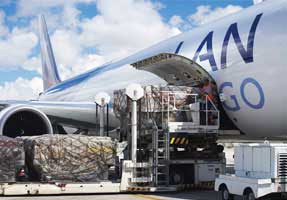
Well positioned for the future: April 2014
In the recent years, South America had made strong headway into global markets with increasing investments from Far East nations like India, Korea, Russia and Vietnam. Economies of Argentina, Brazil, Chile and Columbia and Peru have been the strong growth drivers for air cargo growth in this region. In February this year the International Air […]

In the recent years, South America had made strong headway into global markets with increasing investments from Far East nations like India, Korea, Russia and Vietnam. Economies of Argentina, Brazil, Chile and Columbia and Peru have been the strong growth drivers for air cargo growth in this region. In February this year the International Air Transport Association (IATA) released figures showing a 6.1 percent growth in demand for air freight in November 2013 over the same month in the previous year. November’s performance was considered an improvement on the 4.4 percent year-on-year demand expansion recorded in October. This continues an improvement trend in the weak air cargo markets which has been developing over 2013, stated the report.However, Latin American airlines experienced a slight year-on-year decline in freight demand of 0.1 percent in November, following a 2.0 percent increase in October. However, the growth rate of 3.2 percent during the first 11 months of 2013 is the second-fastest among the regions.
Air freight demand has been supported by solid growth in Latin American trade volumes, but contained by the sluggish performance of Brazil, the region’s largest market.As per IATA’s outlook for this year, Latin American airlines are expected to post a $1 billion profit. This is $500 million less than previously projected, following a weaker than expected improvement in 2013. But the outcome this year is still more than double the $400 million profit recorded in 2013. Poor economic performance in Argentina and Brazil are the main drivers of the reduced profitability expectations, along with the continued political and social unrest in Venezuela. An improved industry structure achieved through consolidation (within Brazil and across borders) and a closer matching of capacity to demand are driving improvements over the 2013 performance.Latin American carriers recorded solid growth of 6.8 percent compared to January last year, a welcome improvement after the slow growth of 2.4 percent in 2013. Expected growth in trade volumes should underpin further cargo expansion. But, weakness in Brazil, Latin America’s largest economy, could dampen the growth potential in the region. At the same time capacity fell by 0.6 percent.
The South American market is beaming with opportunities for air cargo trade. Mexico is a strong trading partner with Brazil, driving intra-Latin America growth. Out of Chile, there is a lot of mining equipment and perishables. “The South American market looks strong thanks to the good performance of the commodities in the region. For exports from Peru to North America we expect the 2014 market to remain at the same level as in 2013, after a good year with 6 percent growth in 2013 versus 2012,” says Álvaro Carril, senior VP sales and marketing at LAN Cargo.With over 80 years experience in freight transport, LAN CARGO, and its subsidiaries -ABSA in Brazil, MAS AIR in Mexico and Linea Aerea Carguera de Colombia in Colombia- are the largest air cargo operators in Latin America.
The South America-North America air cargo trade is estimated to grow at an average annual rate of 5.8 perecent over the next 20 years. Confirming this, Carril expects the Chile to North America market to continue its upward trend, growing at about +5 percent thanks to salmon. “As far as exports to Europe, we expect the market to rebound after a fall in the levels of hake in 2013. For flowers we expect an average growth of 5 percent to North America,” he further adds. About five years ago, salmon exports were hit badly because of the virus salmon anemia. Fortunately, with time the production and export levels of salmon have reached normal levels. Key commodities that have been driving air cargo growth are salmon exports from Chile, flowers from Colombia and Ecuador, and in the case of exports from Peru- asparagus and mangoes to Europe. “For products imported to South America, we see mainly machinery, electronics, auto parts and pharmaceuticals,” says Carril
One of the main challenges in South America is the traffic imbalance. This requires intelligent network steering to optimize onloads in both directions. “We do not expect major changes on imports to the region, which will be subject mainly to what happens in Brazil, the World Cup and economic performance,” confirms Carril. In another report by European Union stated that the first nine months of 2013 confirm the most recent trend, with EU28 exports to Brazil continuing to increase, from 29.6 billion euro in the first nine months of 2012 to 30.4 billion in the same period of 2013, while imports continued to fall, from 28.8 billion to 24.9 billion over the same period. As a result, the EU28 surplus in trade of goods with Brazil of 0.8 billion in the first nine months of 2012 increased significantly to 5.5 billion in the same period of 2013. Brazil accounted for just over 2 percent of the EU28’s international trade in goods, and was amongst the EU28’s ten most important trading partners in the first nine months of 2013.
For LAN Cargo, one of the challenges is the increase in supply of passenger and cargo flights that is occurring in South America due to fleet changes by operators and increased frequencies from European and Asian companies currently operating in the region. “All this translates into a greater capacity installed in the region. On the other hand, the flow of southbound cargo fails to rebound after the fall of the last few years, which creates an imbalance between the cargo exports and imports via air in South America,” says Carril.
Though it is hard to predict the future of air cargo in South America, the main plan for LAN Cargo is to continue strengthening the merger with TAM in terms of connectivity, mainly by strengthening the Guarulhos hub. “It allows us to better reach North America and Europe,” says Carril. For now the carrier continues focusing on filling bellies of passenger planes on LAN routes. “On the other hand, the regional freighter in its Congonhas-Ezeiza - Santiago - Guarulhos route will continue operating this year, allowing for better filling of flights departing from Guarulhos,” says Carril.

